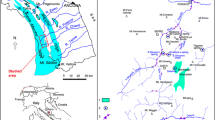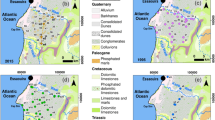Abstract
In this research, the effects of a number of physical/chemical factors such as pH, sunlight, temperature, and salinity, as well as adsorption in porous media on the applicability of selected groundwater tracers are evaluated. Tracers from different categories as fluorescent dye tracers (uranine, eosin, and rhodamine B), chemical salts (NaCl and KCl), and non-fluorescent dye tracer (KMnO4) have been tested. This research was conducted in the laboratory. The results show that uranine losses its florescence in acid environments, while in alkaline conditions its florescence increases. The results also show that due to photochemical decay, eosin is the most unstable tracer if subjected to sunlight. KMnO4 turns to brown under sunlight and high temperature conditions, and may lose its usefulness as a tracer. Results also confirm that the fluorescence intensity of rhodamine B decreases with increasing temperature and/or salinity. Uranine and eosin have high resistance against high temperature and salinity conditions. An important factor in ground water tracing is adsorption of tracer in porous media environment. Our research show that rhodamine B would easily adsorb to fine grain porous media, while uranine and eosin are of high resistance against adsorption; KMnO4 is adsorbed easily too.






Similar content being viewed by others
References
Ammann A, Hoehn E, Koch S (2003) Ground water pollution by roof runoff infiltration evidenced. Water Res 37:1143–1153
Arsnow GF, Vancil MA, Schreiber RP, Ramacciotti CN (2010) Dye tracer study—tried and true method yields surprising results. Proc Annu Int Conf Soil Sediments Water Energy 15:335–350
Benischke R (2005) Fluorescent tracers in hydrology. Austria: Institute for Geothermic and Hydrogeology, Graz
Buzády A, Erostyák J, Paál G (2006) Determination of uranine tracer dye from underground water of Mecsek Hill, Hungary. J Biochem Bioph Methods 69:207–214
Davis SN, Campbell D, Bentley HW, Flynn TJ (1985) Ground water tracers. National Water Well Association, Worthington Ohio
Einsiedl F (2005) Flow system dynamics and water storage of a fissured-porous karst. J Hydrol 312:312–321
Gerke KM, Sidle RC, Mallants D (2013) Criteria for selecting fluorescent dye tracers for soil hydrological applications using uranine as an example. J Hydrol Hydromech 61(4):313–325
Imes JL, Fredrick BS (2002) Using dye-tracing and chemical analyses to determine effects of a wastewater discharge to Jam Up Creek on water quality of Big Spring, Southeastern Missouri. U.S. Geol. Surv. Fact Sheet 103-02: 6
Käss W (1998) Tracing Technique in Geohydrology. Germany: Umkirch, LKr. Breisgau-Hochschwarzwald
Leibundgut Ch, Maloszewski P and Külls Ch (2009) Tracers in Hydrology. John Wiley & Sons: 432
Lindqvist L (1960) A flash photolysis study of fluorescein. Ark Kemi 16(8):79–137
Mon J, Flury M, Harsh JB (2006) Sorption of four trarylmethan dyes in a sandy soil determined by batch and column experiments. J Geoderma 133:217–224
Morales T, Valderrama IF, Uriarte JA, Antigüedad I, Olazarn M (2007) Predicting travel times and transport characterization in karst conduits by analyzing tracer breakthrough curves. J Hydrol 334(1–2):183–198
Seiler K, Maloszewski P, Behrens H (1989) Hydrodynamic dispersion in karstified limestones and dolomites in the upper Jurassic of the Franconia Alb. J Hydrol 108:235–247
Smart PL, Laidlaw IMS (1977) An evaluation of some fluorescent dyes for water tracing. J Water Resour Res 13(1):15–33
Acknowledgment
The authors wish to thank Water Resources Institute of Iran, Office of Applied Research for financially supporting this research coded WRE-82097.
Author information
Authors and Affiliations
Corresponding author
Rights and permissions
About this article
Cite this article
Jafari, F., Balderer, W.P., Jahani, H.R. et al. Lab-evaluation of applicability selected hydrogeological tracers in physical/chemical conditions. Arab J Geosci 8, 3811–3819 (2015). https://doi.org/10.1007/s12517-014-1428-5
Received:
Accepted:
Published:
Issue Date:
DOI: https://doi.org/10.1007/s12517-014-1428-5




